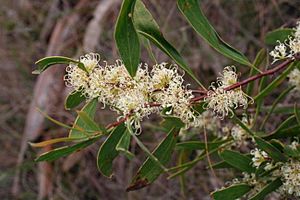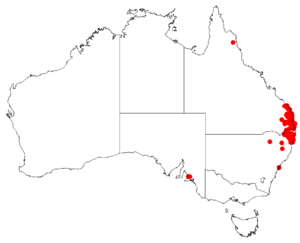Three-nerved willow hakea facts for kids
Quick facts for kids Three-nerved willow hakea |
|
|---|---|
 |
|
| Hakea florulenta growing near Grafton | |
| Scientific classification | |
| Genus: |
Hakea
|
| Species: |
florulenta
|
 |
|
| Where Hakea florulenta is found (data from AVH) | |
Hakea florulenta, also known as the three-nerved willow hakea, is a type of woody shrub. It belongs to the plant family Proteaceae. This plant is special because it is only found naturally in eastern Australia.
What Does It Look Like?
The three-nerved willow hakea is a small, upright shrub. It usually grows to be about 1 to 3 meters (3 to 10 feet) tall. This plant has a special woody swelling at its base called a lignotuber. This helps it regrow after fires.
Its leaves are shaped like a spear, wider at the tip. They are about 6 to 13 centimeters (2 to 5 inches) long and 1.4 to 3 centimeters (0.5 to 1.2 inches) wide. The ends of the leaves are usually rounded, but sometimes they can be sharply pointed.
Between 14 and 20 white flowers grow together in small groups. These flower groups appear on short stems where the leaves join the branches.
After flowering, the plant produces fruit. The fruit is shaped like an oval, but a bit slanted. It is about 2 to 2.6 centimeters (0.8 to 1 inch) long and 0.6 to 1.2 centimeters (0.2 to 0.5 inches) wide in the middle. The surface of the fruit has black, blister-like bumps and tapers to a short, pointed tip. This hakea usually flowers from September to December.
How Was It Named?
The Hakea florulenta was first officially described in 1855. This description was made by a scientist named Carl Meissner. He studied a plant sample collected near Moreton Bay by Frederick Strange.
The description was published in a science journal called Hooker's Journal of Botany and Kew Garden Miscellany. The second part of its scientific name, florulenta, comes from a Latin word. It means "full of flowers" or "flowering a lot." This name perfectly describes the plant's many blooms.
Where Does It Grow?
The three-nerved willow hakea grows in coastal areas of south-eastern Queensland and northern New South Wales. You can find it from Bundaberg in the north down to Grafton in the south.
It often grows in open forests. You might see it near other plants like Melaleuca trees. It prefers sandy soil or areas with sandstone, and sometimes it grows in places where the ground doesn't drain water very well.

